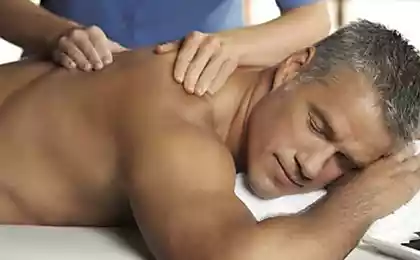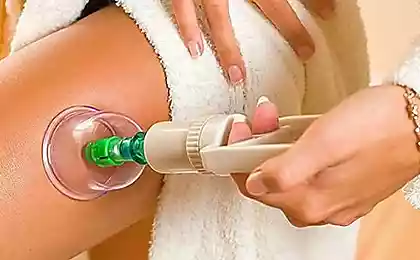744
Unique rehabilitation techniques: exercises and techniques of acupressure massage
Olsha interest to massage the so-called "Chinese point" (biologically active). At the heart of it, as in the case of acupuncture, it is a reflex effects through the central nervous system in the mechanisms regulating functions of internal organs and body systems.
In the human body there are about 700 such points. With the help of modern equipment it found that these tiny areas of skin have a high level of metabolic processes, enhanced absorption of oxygen, high temperature and special bioelectric mode (electrical resistance of the skin in the area of biologically active points decreases sharply, as if an invisible door opening into the body). The skilled artisan can determine the biologically active points on the touch.
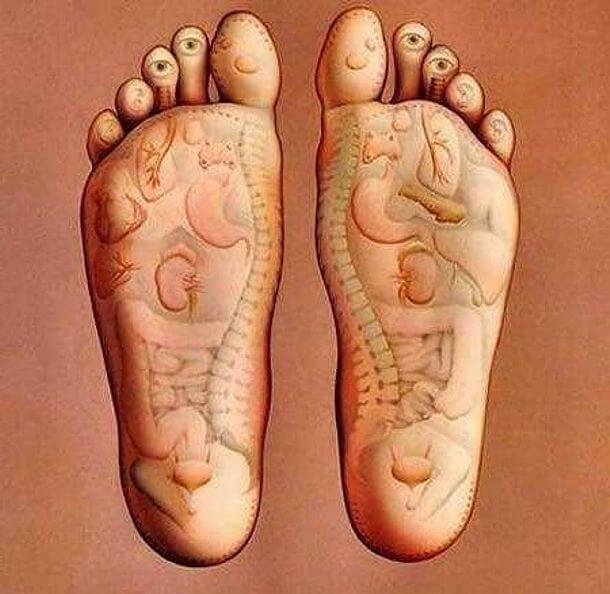
By selecting a combination of points by varying the shape, extent and duration of stimulation, can affect the function of one or another internal organ.
In 1961, a Korean professor Kim Bong Han has been detected in the human body Kenrak system, wherein both the nervous system and on the blood and lymphatic vessels. It is believed that this system connects the "Chinese terms" to the internal organs. Also expressed the assumption that the system is transmitted and the impact of bio psychics.
The following are suggested some exercises with the use of a point of self-massage to address a variety of disorders in the body.
1. Stand with your heels together, toes apart. Rhythmically rise on your toes and go down on the heels of 10-20 times, so that the ankle rubbed one against the other.
This exercise, by acting on the active points of the ankles, stimulates the activity of the digestive tract. If the breath to do as if to yawn (with mouth closed), described the movement and have a restorative effect.
When you have finished the exercise, you have to sit down, put your foot on the leg and powerful tweaks promassirovat Achilles tendon. The same is done on the other foot. Takoe tendons tingle helps to restore the functions of sexual glands.
Then should perform a quick rubbing hands (arms bent at the elbows, in front of chest). Rub until sensation of strong heat. Then shake hands, slowly raising and lowering the arms. (To improve blood circulation.)
2. Sit on a chair. Using your fingertips, rub both hands from the top down the upper gums. If these movements are combined with an infringement of the fingers of the narrow bridge, they tone up the brain activity. This effect is enhanced if after the massage the upper gums produce effleurage (half-bent fingers) along the spine and lower back. This is easiest to do self-massage on his knees, torso slightly forward. Breathing should be uniform. Duration tapping - to the feeling of comfort
. 3. Sit on a chair. The left hand put on the left side (the region of the spleen), right hand - the right (liver area), four fingers of each hand to advance in the ribs. Breath deep, diaphragmatic. Number of breaths -. 4-12
Finish the exercise by rubbing palms armpits (there are located active points, regulating the liver and spleen), the calf muscles (bottom-up), tapping the top of the head with fingertips (imitation piano), rubbing the feet with a dry brush or skating foot (sitting) on the floor gymnastics sticks. (To improve metabolism).
4. Sit in the chair. 4 to press the point on the lips alternately to 3 seconds. fingertip. Initially pushing on one point, after a short break (10-15 sec.) At the second and, finally, simultaneously on the third and fourth. This exercise helps to relax the muscles of the body. Then stay comfortably in a chair, relax by imitating falling asleep, and slows breathing, especially lengthening the exhalation. This exercise will quickly relax (3-5 min.) After the hard work.
5. Sit in a chair. Press down on the anti-stress point that is located under the chin. Duration 3 sec pressing. This exercise helps to relieve the excessive reactions to neuro-rereadings from an emotions voltage (pre-exercise should be performed 4).
After pressure on the anti-stress point should be comfortable to sit in a chair, relax and imagine the state of languor, the flight of birds in the blue sky. After 3-5 min. We need to reach out to yawn, tensing and then relaxing the muscles of the arms and legs.
6. Lie down on the bed. Press with fingertips on the forehead and scalp. Start by clicking on the middle line of the forehead with two fingers on both sides. Then you need to press on the scalp four fingers of both hands (respectively on the left and right side). Each pressing lasts 3 seconds. Moving the fingers upward, eventually pressing is performed at 16 points on each side of the head. Last pressure on the scalp should be delayed until 5 seconds. Self-massage session lasts 3-10 minutes.
It uprazhnenieuluchshaet sleep. In protracted sleep disturbances, especially after long-term use of sleeping pills, you must first roll the foot gymnastic stick, and after self-massage of points on the head massage 4 points, helps to relax the muscles.
7. Lie on your bed, close your eyes. Easily and quickly rubbing the eyeballs. This exercise will help to normalize the excessive appetite, as for the eyeballs are active points, reflex regulating the activity of the digestive tract - stomach and intestines. Massaging is recommended to do in the morning before eating. It should be mentally say "appetite normalizes. I'll eat less and move more. »
Note by the way that being overweight "melted" rather if, along with a morning psychophysical exercise daily walk 2-6 km at an accelerated pace to a light sweat. It is necessary to avoid shortness of breath and heart rate increase of more than 100-120 beats / min. length of the route should be increased gradually, after a walk to take a shower.
8. Sit on a chair, his legs crossed. Press down on the active points of the sole.
1 - with the pituitary gland, 2 - with the frontal sinuses, 3 - neck, 4 - throat, 5 - with the thyroid gland, 6 - with the pancreas, 7 - to the stomach, 8 - from the adrenal glands, 9 - with the dorsal vertebrae, 10 - kidney, 11 - with the transverse colon, 12 - from the small intestine, 13 - from the cecum, 14 - lower back, 15 - with the eyes, 16 - with ears, 17 - with the right light, 18 - liver, 19 - gallbladder, 20 with the ascending colon, 21 - from the appendix, 22 - with right knee, 23 - from the left lung, 24 - with a heart 25 - the spleen, 26 - with a thick descending colon, 27 - with the left knee .
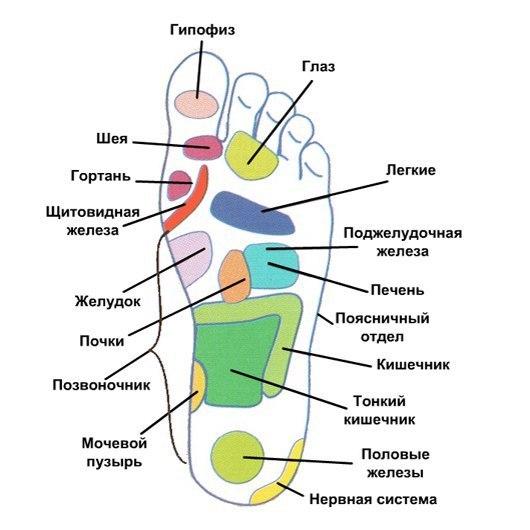
This exercise stimulates the function of many organs. To make a massage as a prophylactic measure to be on all the points of the soles of both feet. Push Force should be increased gradually. Stimulation of the points should finish stroking the entire foot.
To have a general impact on all active points of the soles should be sitting feet to roll on the floor gymnastic stick. The duration of the self-massage 3-10 minutes.
One of the objective reasons, sedentary lifestyle is a leg disease and age-related changes of foot shape (in the elderly is often given lateral bone, foot width increased by 10 mm).
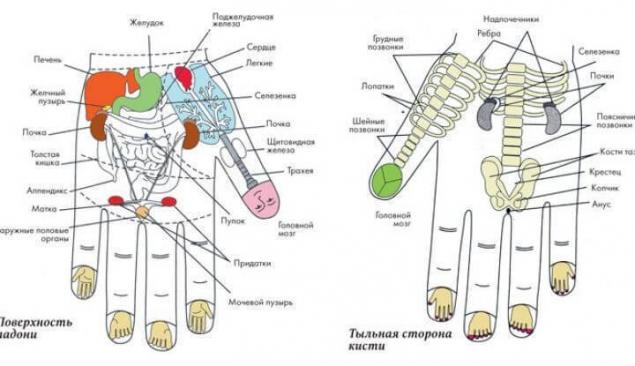
Observations of experts show that 25% of women and 20% of men after 50 years of developing flatfoot. Often, the formation of "spurs" because of salt deposits. Lack of physical activity after the age of 30 years leads to a reduction in the number of functioning capillaries, a narrowing of the lumen, decrease the permeability of the capillary walls.
All this leads to the development of different kinds of neurovascular disorders that can become a cause of obliterating endarteritis, often accompanied by inflammation of the vein wall and vein blockage of blood clots. Therefore legs, mostly calves and feet, require careful and thoughtful care.
Below are some of the exercises and techniques of self-massage of the feet, which will help you to a great extent prevent the above troubles.
In a n d a n g e n s
1. Flex and straighten the toes.
2. Circular motion feet from left to right and vice versa (sitting, feet on weight).
3. Walking barefoot on the side and the outer edges of the foot.
4. Stop rolling from the outside to the inside (feet shoulder width apart, feet parallel).
5. Bend and straighten your legs (sitting on a chair).
6. Circular kicking motion, rotating them in the knee joints (feet on weight).
7. Circular Motion knees slightly squatting and sitting up (standing, holding on to his chair).
8. Wide primaries feet forward - backward (standing, holding on to his chair)
. 9. The circular motion feet, describing a circle, alternately one or the other leg (standing, holding on to his chair).
In the human body there are about 700 such points. With the help of modern equipment it found that these tiny areas of skin have a high level of metabolic processes, enhanced absorption of oxygen, high temperature and special bioelectric mode (electrical resistance of the skin in the area of biologically active points decreases sharply, as if an invisible door opening into the body). The skilled artisan can determine the biologically active points on the touch.

By selecting a combination of points by varying the shape, extent and duration of stimulation, can affect the function of one or another internal organ.
In 1961, a Korean professor Kim Bong Han has been detected in the human body Kenrak system, wherein both the nervous system and on the blood and lymphatic vessels. It is believed that this system connects the "Chinese terms" to the internal organs. Also expressed the assumption that the system is transmitted and the impact of bio psychics.
The following are suggested some exercises with the use of a point of self-massage to address a variety of disorders in the body.
1. Stand with your heels together, toes apart. Rhythmically rise on your toes and go down on the heels of 10-20 times, so that the ankle rubbed one against the other.
This exercise, by acting on the active points of the ankles, stimulates the activity of the digestive tract. If the breath to do as if to yawn (with mouth closed), described the movement and have a restorative effect.
When you have finished the exercise, you have to sit down, put your foot on the leg and powerful tweaks promassirovat Achilles tendon. The same is done on the other foot. Takoe tendons tingle helps to restore the functions of sexual glands.
Then should perform a quick rubbing hands (arms bent at the elbows, in front of chest). Rub until sensation of strong heat. Then shake hands, slowly raising and lowering the arms. (To improve blood circulation.)
2. Sit on a chair. Using your fingertips, rub both hands from the top down the upper gums. If these movements are combined with an infringement of the fingers of the narrow bridge, they tone up the brain activity. This effect is enhanced if after the massage the upper gums produce effleurage (half-bent fingers) along the spine and lower back. This is easiest to do self-massage on his knees, torso slightly forward. Breathing should be uniform. Duration tapping - to the feeling of comfort
. 3. Sit on a chair. The left hand put on the left side (the region of the spleen), right hand - the right (liver area), four fingers of each hand to advance in the ribs. Breath deep, diaphragmatic. Number of breaths -. 4-12
Finish the exercise by rubbing palms armpits (there are located active points, regulating the liver and spleen), the calf muscles (bottom-up), tapping the top of the head with fingertips (imitation piano), rubbing the feet with a dry brush or skating foot (sitting) on the floor gymnastics sticks. (To improve metabolism).
4. Sit in the chair. 4 to press the point on the lips alternately to 3 seconds. fingertip. Initially pushing on one point, after a short break (10-15 sec.) At the second and, finally, simultaneously on the third and fourth. This exercise helps to relax the muscles of the body. Then stay comfortably in a chair, relax by imitating falling asleep, and slows breathing, especially lengthening the exhalation. This exercise will quickly relax (3-5 min.) After the hard work.
5. Sit in a chair. Press down on the anti-stress point that is located under the chin. Duration 3 sec pressing. This exercise helps to relieve the excessive reactions to neuro-rereadings from an emotions voltage (pre-exercise should be performed 4).
After pressure on the anti-stress point should be comfortable to sit in a chair, relax and imagine the state of languor, the flight of birds in the blue sky. After 3-5 min. We need to reach out to yawn, tensing and then relaxing the muscles of the arms and legs.
6. Lie down on the bed. Press with fingertips on the forehead and scalp. Start by clicking on the middle line of the forehead with two fingers on both sides. Then you need to press on the scalp four fingers of both hands (respectively on the left and right side). Each pressing lasts 3 seconds. Moving the fingers upward, eventually pressing is performed at 16 points on each side of the head. Last pressure on the scalp should be delayed until 5 seconds. Self-massage session lasts 3-10 minutes.
It uprazhnenieuluchshaet sleep. In protracted sleep disturbances, especially after long-term use of sleeping pills, you must first roll the foot gymnastic stick, and after self-massage of points on the head massage 4 points, helps to relax the muscles.
7. Lie on your bed, close your eyes. Easily and quickly rubbing the eyeballs. This exercise will help to normalize the excessive appetite, as for the eyeballs are active points, reflex regulating the activity of the digestive tract - stomach and intestines. Massaging is recommended to do in the morning before eating. It should be mentally say "appetite normalizes. I'll eat less and move more. »
Note by the way that being overweight "melted" rather if, along with a morning psychophysical exercise daily walk 2-6 km at an accelerated pace to a light sweat. It is necessary to avoid shortness of breath and heart rate increase of more than 100-120 beats / min. length of the route should be increased gradually, after a walk to take a shower.
8. Sit on a chair, his legs crossed. Press down on the active points of the sole.
1 - with the pituitary gland, 2 - with the frontal sinuses, 3 - neck, 4 - throat, 5 - with the thyroid gland, 6 - with the pancreas, 7 - to the stomach, 8 - from the adrenal glands, 9 - with the dorsal vertebrae, 10 - kidney, 11 - with the transverse colon, 12 - from the small intestine, 13 - from the cecum, 14 - lower back, 15 - with the eyes, 16 - with ears, 17 - with the right light, 18 - liver, 19 - gallbladder, 20 with the ascending colon, 21 - from the appendix, 22 - with right knee, 23 - from the left lung, 24 - with a heart 25 - the spleen, 26 - with a thick descending colon, 27 - with the left knee .

This exercise stimulates the function of many organs. To make a massage as a prophylactic measure to be on all the points of the soles of both feet. Push Force should be increased gradually. Stimulation of the points should finish stroking the entire foot.
To have a general impact on all active points of the soles should be sitting feet to roll on the floor gymnastic stick. The duration of the self-massage 3-10 minutes.
One of the objective reasons, sedentary lifestyle is a leg disease and age-related changes of foot shape (in the elderly is often given lateral bone, foot width increased by 10 mm).

Observations of experts show that 25% of women and 20% of men after 50 years of developing flatfoot. Often, the formation of "spurs" because of salt deposits. Lack of physical activity after the age of 30 years leads to a reduction in the number of functioning capillaries, a narrowing of the lumen, decrease the permeability of the capillary walls.
All this leads to the development of different kinds of neurovascular disorders that can become a cause of obliterating endarteritis, often accompanied by inflammation of the vein wall and vein blockage of blood clots. Therefore legs, mostly calves and feet, require careful and thoughtful care.
Below are some of the exercises and techniques of self-massage of the feet, which will help you to a great extent prevent the above troubles.
In a n d a n g e n s
1. Flex and straighten the toes.
2. Circular motion feet from left to right and vice versa (sitting, feet on weight).
3. Walking barefoot on the side and the outer edges of the foot.
4. Stop rolling from the outside to the inside (feet shoulder width apart, feet parallel).
5. Bend and straighten your legs (sitting on a chair).
6. Circular kicking motion, rotating them in the knee joints (feet on weight).
7. Circular Motion knees slightly squatting and sitting up (standing, holding on to his chair).
8. Wide primaries feet forward - backward (standing, holding on to his chair)
. 9. The circular motion feet, describing a circle, alternately one or the other leg (standing, holding on to his chair).
The drainage system on your site-as select and install
There are 3 exercises that will make the shoulders silnymi




